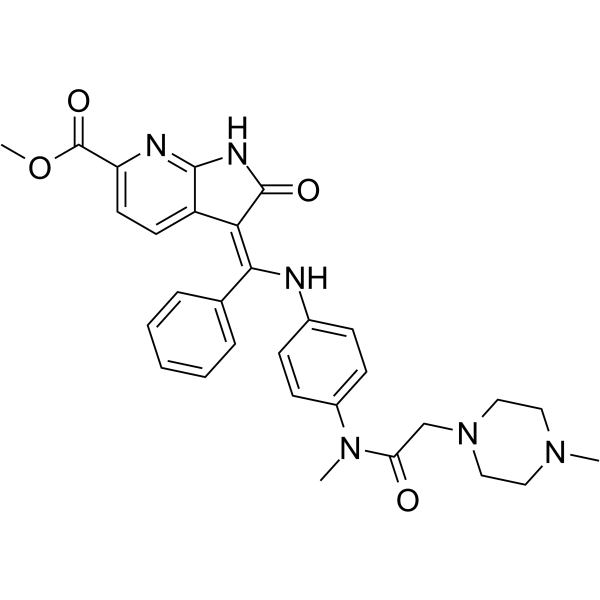产品
编 号:F745305
分子式:C30H32N6O4
分子量:540.61
分子式:C30H32N6O4
分子量:540.61
产品类型
规格
价格
是否有货
1mg
询价
询价
5mg
询价
询价
10mg
询价
询价
结构图

CAS No: 1448874-96-1
产品详情
生物活性:
Ansornitinib is an orally active dual kinase inhibitor that inhibits platelet-derived growth factor receptor (PDGFR) and vascular endothelial growth factor receptor (VEGFR2). Ansornitinib can be used as an antifibrotic agent in lung, liver, kidney, and gastrointestinal fibrotic diseases.
体内研究:
Ansornitinib (compound I) (25 mg/kg, p.o., twice a day, 4 weeks) can reduce fibrosis in TGFβ positive female mice.Ansornitinib (compound I) (5-45 mg/kg, p.o., twice a day, 4 days) can reduce inflammatory bowel disease (IBD) in TNBS-induced IBD/acute colitis male CD-1 mice.Animal Model:8-10 weeks TGFβ positive female mice
Dosage:25 mg/kg
Administration:Oral administration; twice a day; 4 weeks
Result:Reduced lung fibrosis score, lung hydroxyproline levels and αSMA, a marker of early pulmonary fibrosis.
Animal Model:TNBS-induced IBD/acute colitis male CD-1 mice
Dosage:5, 15, 45 mg/kg
Administration:Oral administration; twice a day; 4 days
Result:Improved colonic histology and reduced the TNBS-induced loss of cupped cells at 15 mg/kg and 45 mg/kg significantly.Reduced the expression level of myeloperoxidase (MPO) at 5 mg/kg and 15 mg/kg significantly while there was no statistical difference at 45 mg/kg.
Animal Model:Male Sprague Dawley rats
Dosage:30 mg/kg
Administration:Intravenous injection; once
Result:The pharmacokinetic parameters of Ansornitinib (compound I)ParameterAnsornitinib (compound I)
t1/24.1 h
Tmax0.518 h
Cmax7860 ng/mL
Clearance173 mL/kg/min
steady-state volume18.2 L/kg
AUC0-last3180 ng/mL*h
AUC0?inf_obs3200 ng/mL*h
体外研究:
Ansornitinib (compound I) (0.1 nM-10 μM, 2 h) can significantly inhibit the phosphorylation of PDGFRβ in human hepatic stellate cells and KDR phosphorylation in human umbilical vein endothelial cells (HUVEC).Ansornitinib (compound I) (0.1-13 μM, 48 h) can induce a decrease in the expression of many different inflammation-related markers, such as macrophage colony-stimulating factor (M-CSF), soluble interleukin 8, and fibrosis-related markers, such as N-calmodulin, α-SMA, etc., in a dose-dependent manner.
Ansornitinib is an orally active dual kinase inhibitor that inhibits platelet-derived growth factor receptor (PDGFR) and vascular endothelial growth factor receptor (VEGFR2). Ansornitinib can be used as an antifibrotic agent in lung, liver, kidney, and gastrointestinal fibrotic diseases.
体内研究:
Ansornitinib (compound I) (25 mg/kg, p.o., twice a day, 4 weeks) can reduce fibrosis in TGFβ positive female mice.Ansornitinib (compound I) (5-45 mg/kg, p.o., twice a day, 4 days) can reduce inflammatory bowel disease (IBD) in TNBS-induced IBD/acute colitis male CD-1 mice.Animal Model:8-10 weeks TGFβ positive female mice
Dosage:25 mg/kg
Administration:Oral administration; twice a day; 4 weeks
Result:Reduced lung fibrosis score, lung hydroxyproline levels and αSMA, a marker of early pulmonary fibrosis.
Animal Model:TNBS-induced IBD/acute colitis male CD-1 mice
Dosage:5, 15, 45 mg/kg
Administration:Oral administration; twice a day; 4 days
Result:Improved colonic histology and reduced the TNBS-induced loss of cupped cells at 15 mg/kg and 45 mg/kg significantly.Reduced the expression level of myeloperoxidase (MPO) at 5 mg/kg and 15 mg/kg significantly while there was no statistical difference at 45 mg/kg.
Animal Model:Male Sprague Dawley rats
Dosage:30 mg/kg
Administration:Intravenous injection; once
Result:The pharmacokinetic parameters of Ansornitinib (compound I)ParameterAnsornitinib (compound I)
t1/24.1 h
Tmax0.518 h
Cmax7860 ng/mL
Clearance173 mL/kg/min
steady-state volume18.2 L/kg
AUC0-last3180 ng/mL*h
AUC0?inf_obs3200 ng/mL*h
体外研究:
Ansornitinib (compound I) (0.1 nM-10 μM, 2 h) can significantly inhibit the phosphorylation of PDGFRβ in human hepatic stellate cells and KDR phosphorylation in human umbilical vein endothelial cells (HUVEC).Ansornitinib (compound I) (0.1-13 μM, 48 h) can induce a decrease in the expression of many different inflammation-related markers, such as macrophage colony-stimulating factor (M-CSF), soluble interleukin 8, and fibrosis-related markers, such as N-calmodulin, α-SMA, etc., in a dose-dependent manner.
产品资料

